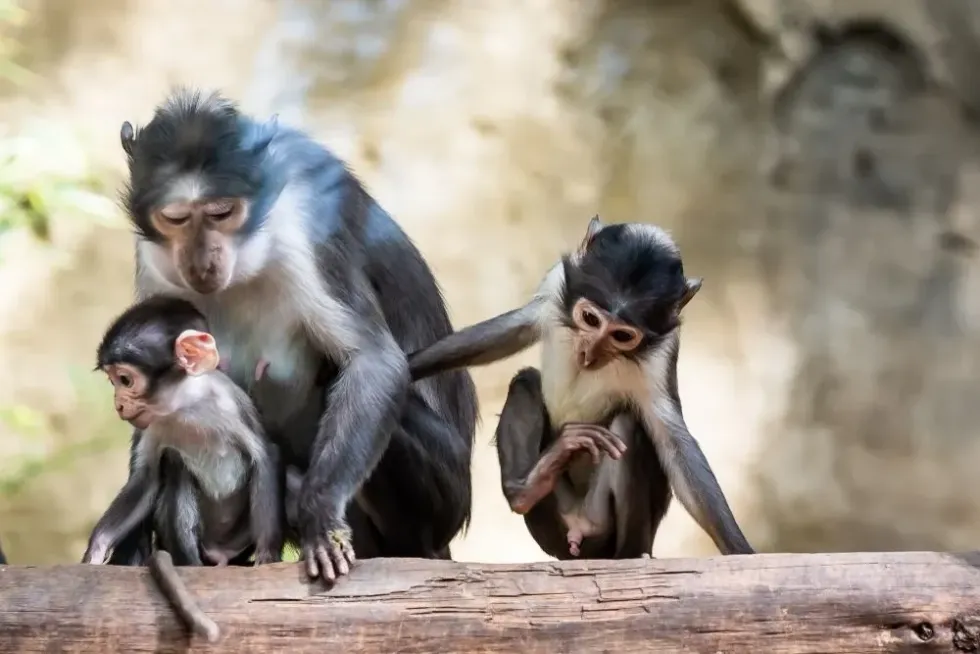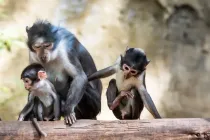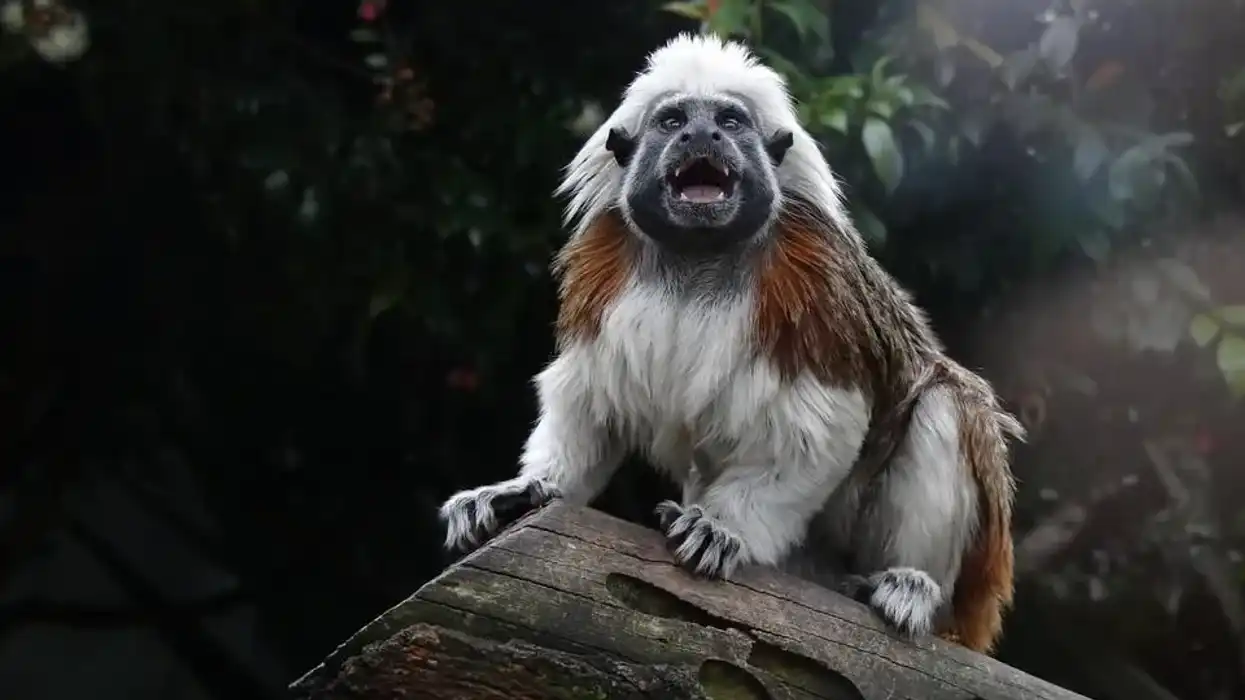Fun Mangabey Facts For Kids
If looking at monkeys jumping around in the zoo, excites you then you’ll love to read about these long-limbed, grey-haired monkeys. Belonging to the mammal class, Mangabey monkeys are dwellers of the tropical forests.
Also known as sooty Mangabeys, these highly social animals spend most of their time protecting their territories using their specialized vocal sac. In fact, the males are comparatively louder than the females here.
Regarding physical appearance, it would not be wrong to say that these monkeys have beautiful uplifted cheekbones contoured with a deep depression right below. These primate species have bright eyes with fur colors ranging from pale grey to dark grey fur.
Like other Old World monkeys, these interesting creatures usually walk with their tails lifted and curved forward and move across grasslands between small patches.
Worryingly, Mangabeys are now among the endangered species, both males and females, due to Mangabey habitat loss, and their survival needs urgent attention and cooperation.
There are quite a few types of Mangabeys, like the white eyelid Mangabeys, collared Mangabey, crested Mangabey, black-crested Mangabey, gray-cheeked Mangabey, and the crested Mangabeys. The red-crowned Mangabey lives in the lush tropical rainforests of West Africa, ranging from Nigeria to Angola.
We have lots of interesting facts on Mangabeys that everyone will enjoy. Let's have a look at these interesting facts, and if you do like these, then read Pygmy Slow Loris and squirrel monkeys too.
Mangabey Interesting Facts
What type of animal is a Mangabey?
Mangabey can be one of the three genera of Old World monkeys named: genus Lophocebus, genus Rungwecebus, and genus Cercocebus. Mangabey is a highly social, loud, and territorial kind of animal and spends most of its time protecting its territories.
What class of animal does a Mangabey belong to?
The mangabey belongs to the Mammal class, with the scientific name of sooty mangabey: Cercocebus atys. They have three genera named: genus Lophocebus, genus Rungwecebus, and genus Cercocebus.
The Cercocebus and Lophocebus were thought to be very closely related, however, now scientists say that the subspecies are more distinguishable and that Cerococebus are closely related to mandrill while the Lophocebus are more closely related to baboons.
How many Mangabeys are there in the world?
The International Union of Conservation of Nature has marked this particular species of monkey as critically endangered, with their population going down rapidly. The last updated and the most recent count rounded off at lower levels of 1300 to 13500 individuals.
Where does a Mangabey live?
Mangabey species are usually spotted in the tropical forests of Africa/ West Africa. They can be spotted in the valley forests or the mountain slopes.
However, most of them are ground-dwelling (which in a way increases their risks of being poached). Their body structure (the limbs, tails, the body fur, and the web between the fingers and toes) is designed best for their survival in the dense forests.
What is a Mangabey's habitat?
The Mangabey prefers living in the forest. Their long limbs and strong long-tail help them jump and cling to the forest branches with a firm hold. They are also blessed with a web between their fingers and toes hence letting them swim better in swamps. Their habitat in a national park is similar to the forest.
Who do Mangabeys live with?
Mangabeys are social animals and therefore believe in moving around with their mates. They believe in the ideology of "having each other's back", therefore they move around the forests in a group of 10 - 40 also known as the troop protecting their territories. They use their communication skills to warn their co-mates hence protecting them as well.
How long does a Mangabey live?
The recorded average life span of a Mangabey is approximately 25-27 years of living.
How do they reproduce?
The mangabey exhibit a highly polygamous mating system with the adult male being the dominating mates. However, the red-capped ones do not have a well-defined period for breeding, with males and adult females attaining maturity from five to seven years of age.
A general reproduction process starts when the female is ready to breed and gives a visual cue for the male. The newborn single infant is given birth after a period of 5.5 months and spends most of their starting days sticking to their mother's belly.
What is their conservation status?
As adorable as they are their count is going down steeply. According to the International Union of Conservation Nature, these Old World monkeys are among the Vulnerable species conservation status, although certain types of Mangabeys are Endangered and Critically Endangered, and are at high risk of being extinct.
Reasons for their endangered conservation status can be the loss of habitat along with poaching and hunting.
Mangabey Fun Facts
What do Mangabeys look like?
Starting with the basics of Mangabey monkey facts, these monkeys have four limbs and a long tail. They have a furry body, the color of which ranges from golden brown, dark brown, gray, and a soft Matt black.
These Old World monkeys are blessed with beautiful facial features (cheek pouches, white eyelids) with a natural contour under the cheekbones (deep depression right under). The eyelids are light-skinned too with gleaming bright eyes. Mangabeys exhibit complex unique ecological features.

How cute are they?
The beautiful facial features of this monkey make them ten times more adorable than the others. They have bright eyes with beautiful eyelids; these baby eyes with white eyelids can melt anyone's heart within seconds.
Their not-so-huge size makes them highly adorable too. Most of the travelers who had the chance to encounter these adorable creatures can't stop talking about how cute they were and how all they wanted to do was hug them!
How do they communicate?
The Mangabeys communicate through their vocals. These Old World monkeys are extremely loud and use their specialized vocal signals to communicate with others. Besides, they have various signals or alarms for various needs like alarm calls or loud warning calls. Along with that, they also use low grunts, high-pitched shrieks, and barks.
Red-capped mangabey facts: these Mangabeys are blessed with a special throat sac, which in turn blesses them with a loud booming voice. Therefore, males have a larger sac, giving them a louder voice to alert their fellow mates by barks or titters or grunts.
On the other hand, the female joins in with the loud chorus. They also make a sound that the biologists have named 'whoop gobble', where whoop means getting the others' attention and gobble being an indication of one's whereabouts. The average range of one km.
On the other hand, the white-collared ones use the movement of their tails to express themselves. Eyelids and eyebrows are a prime source of communication as well.
How big is a Mangabey?
Although these Old World monkeys are not very huge, their size is just apt for the kind of life they live (ie. always moving around).
The average body mass ranges from 20-22 lb (9-10 kg)- males and 17-19 lb (7.5-8.6 kg) - females. The head to body length is 19–26in (47-67 cm) for males and 18–24in (45-60 cm) for females. They are comparatively two to three times size bigger than an average cat's size.
How fast can a Mangabey run?
The Mangabey is a comparatively fast animal and usually covers a home range of around 4-6 km2. These monkeys are usually on a move and therefore have good stamina; jumping around from tree to tree or walking straight on the ground- they cover it all.
How much does a Mangabey weigh?
An average Mangabey weighs around 17-19 lb i. e. 7-8 kg, which is the perfect body weight keeping in mind the body length and the physical activity.
What are their male and female names of the species?
No specific names are given to the males and females of this species. The species are called the Cercocebus torquatus; also known as the red-capped Mangabey or the white-collared Mangabey. Their tribes are Papionini, papionins.
What would you call a baby Mangabey?
Although there is no particular name for a baby Mangabey overall these are called with different names by the local people around, some of them being "the ones with the thin waist" or "four-eyed monkeys". Since these monkeys are highly social therefore their interaction level with the local people around the forests is pretty high.
What do they eat?
Mangabey is blessed with strong jaws and molars and hence giving them a mouth strong enough to tear through hard nut fruits. They not only feed on fruits but also prefer feasting on leaves or nuts or insects or seeds. They also consume spiders roaming around in the jungle.
Are they loud?
As we get to know more about this species of animal, we get to know that these monkeys use very interesting ways of communicating with the others in their class. Peculiar ways of communication are prime to their species as seeing through the dense forests of tropical is quite a tough job.
Therefore these Mangabeys have a special throat sac which in turn blesses them with a loud booming voice. The males (alpha male) have a larger sac, therefore, giving them a louder voice which enables him to alert his fellow mates by barks or titters or grunts.
On the other hand, the female joins in with the loud chorus.
These also make a sound which the biologists have named 'whoop gobble', where whoop means getting the attention of the others and gobble being an indication of one's whereabouts. They have an average range of one km.
Would they make a good pet?
Mangabeys prefer staying in the jungles. Being social animals, they would make fairly good pets but keeping in mind their endangered status, it is not at all advised to consider having them as a pet.
Did you know...
These Old World monkeys have quite a few peculiar habits. Like most of them spend most of their time on the tress however the white-eyelid mangabeys are comfortable traveling on the ground as well.
The typical mangabey has webbing between their fingers and toes which in a way help them swim while the long limbs make them great jumpers with their long tails helping them to hook themselves up to the tree branches.
Different types of Mangabey monkeys
There are various kinds of Mangabey spotted in the jungle.
Names of some of which are jotted down here: sooty Mangabey or white-collared Mangabey or white-naped Mangabey, Tana River Mangabey, golden-bellied Mangabey, red-capped Mangabey also known as the collared Mangabey and the white-collared Mangabey, agile Mangabey, white-eyelid Mangabey, crested Mangabey, they gray-cheeked Mangabey or white-cheeked Mangabey, and Sanje Mangabey are the few varieties of Mangabey that exist today.
Are the Mangabeys endangered?
The population of Mangabeys has visibly declined by 50 percent in a time period less than three decades. The International Union of Conservation of Nature has marked this particular monkey species as having a highly endangered conservation status, with their population falling rapidly.
The last updated and the most recent count rounded off at around 1300 to 13500 individuals. Unfortunately, according to their most recent conservation status, the Mangabey is endangered.
Here at Kidadl, we have carefully created lots of interesting family-friendly animal facts for everyone to discover! Learn more about some other mammals including vervet monkey, or New World monkeys.
You can even occupy yourself at home by drawing one on our Mangabey coloring pages.
We Want Your Photos!
More for You
See All
Bachelor of Commerce specializing in Accounting and Finance, Master of Business Administration

Divya RaghavBachelor of Commerce specializing in Accounting and Finance, Master of Business Administration
With a diverse range of experience in finance, administration, and operations, Divya is a diligent worker known for her attention to detail. Born and raised in Bangalore, she completed her Bachelor's in Commerce from Christ University and is now pursuing an MBA at Narsee Monjee Institute of Management Studies, Bangalore. Along with her professional pursuits, Divya has a passion for baking, dancing, and writing content. She is also an avid animal lover who dedicates her time to volunteering for animal welfare causes.
Disclaimer
1) Kidadl is independent and to make our service free to you the reader we are supported by advertising. We hope you love our recommendations for products and services! What we suggest is selected independently by the Kidadl team. If you purchase using the Buy Now button we may earn a small commission. This does not influence our choices. Prices are correct and items are available at the time the article was published but we cannot guarantee that on the time of reading. Please note that Kidadl is a participant in the Amazon Services LLC Associates Program, an affiliate advertising program designed to provide a means for sites to earn advertising fees by advertising and linking to Amazon. We also link to other websites, but are not responsible for their content.
2) At Kidadl, we strive to recommend the very best activities and events. We will always aim to give you accurate information at the date of publication - however, information does change, so it’s important you do your own research, double-check and make the decision that is right for your family. We recognise that not all activities and ideas are appropriate for all children and families or in all circumstances. Our recommended activities are based on age but these are a guide. We recommend that these ideas are used as inspiration, that ideas are undertaken with appropriate adult supervision, and that each adult uses their own discretion and knowledge of their children to consider the safety and suitability. Kidadl cannot accept liability for the execution of these ideas, and parental supervision is advised at all times, as safety is paramount. Anyone using the information provided by Kidadl does so at their own risk and we can not accept liability if things go wrong.
3) Because we are an educational resource, we have quotes and facts about a range of historical and modern figures. We do not endorse the actions of or rhetoric of all the people included in these collections, but we think they are important for growing minds to learn about under the guidance of parents or guardians.







